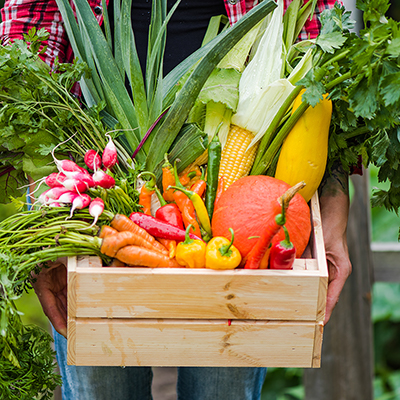How to Grow Asparagus

Last updated September 7, 2023
Unlike other vegetables in the garden, you will need to plant asparagus, which is a perennial, just one time. You can pick a few spears, or shoots, in the first few years after planting, but asparagus needs time to mature. After that, the plants can produce a bountiful harvest for as long as 20 to 30 years.
Difficulty:
Beginner
Duration:
Under 2 hours
Table of Contents
How to Make an Asparagus Bed
How to Plant and Grow Asparagus
How to Harvest Asparagus
How to Preserve Asparagus
How to Handle Insects and Diseases
How to Grow Male and Female Asparagus Plants
How to Make an Asparagus Bed
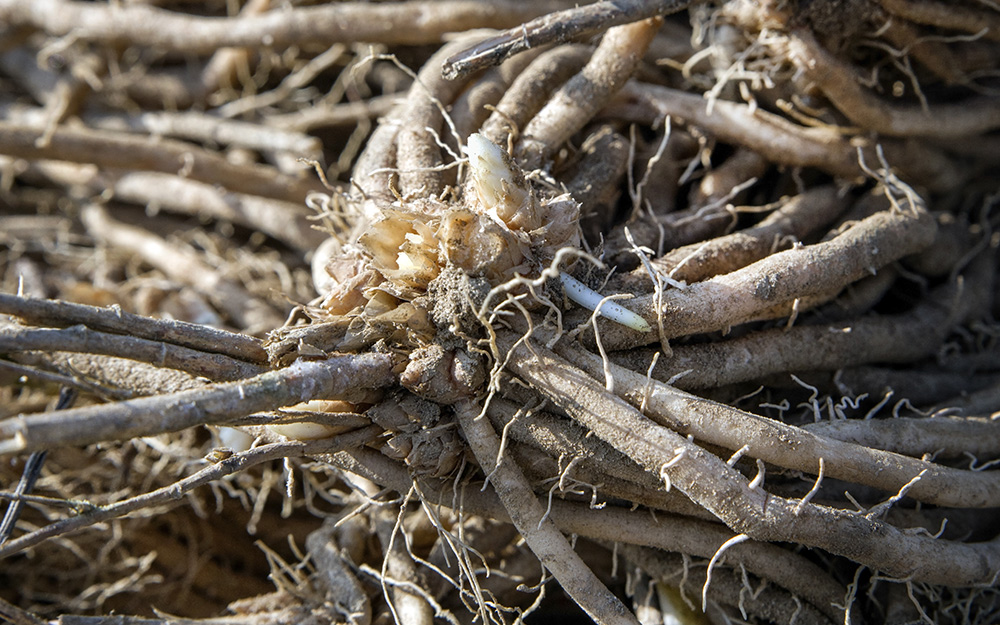
Asparagus is grown from crowns, or 1 year old plants, that are typically sold in early spring. They’ll grow in most parts of the U.S., but they do best in cool climates where they can go completely dormant during a long winter.
You may hear them referred to as roots.
- A good rule of thumb is to plant 25 asparagus plants for a family of four. You may want more if you plan to freeze some for the winter.
- Since you’re planting only once, choose a well-drained garden spot that gets plenty of sun for your permanent asparagus bed. The plants can tolerate some light shade but produce better in a sunny location.
- For best results, prepare the bed in the fall before you plan to plant. Remove all the grass and weeds from the bed, because they’ll be very hard to get out after the asparagus starts growing. Then work in several inches of compost or old, shredded leaves.
- Next, ask your local County Extension Service to test your soil. Tell the agent you’re growing asparagus, so you’ll recieve the correct recommendations for soil amendments, if any. You can also test your soil with a purchased test kit. Asparagus likes a pH of 6.5 to 7.0 and doesn’t do well if the pH is below 6.0.
- If your bed needs amendments, work them in thoroughly.
- Pulverized, pelletized or granular limestone will raise the pH. Sulfur will lower it. Refer to your test results to know how much to use and re-test yearly to see if you need to adjust the pH again.
- Asparagus needs soil that stays consistently moist, but not soggy, so you may want to add a drip irrigation system or soaker hose to the bed, too.
- Mulch the bed over the winter, or grow a cool season cover crop, such as annual ryegrass, that you can turn over and work into the soil before spring arrives. This can help hold down weeds, prevent erosion and improve your soil.
How to Plant and Grow Asparagus
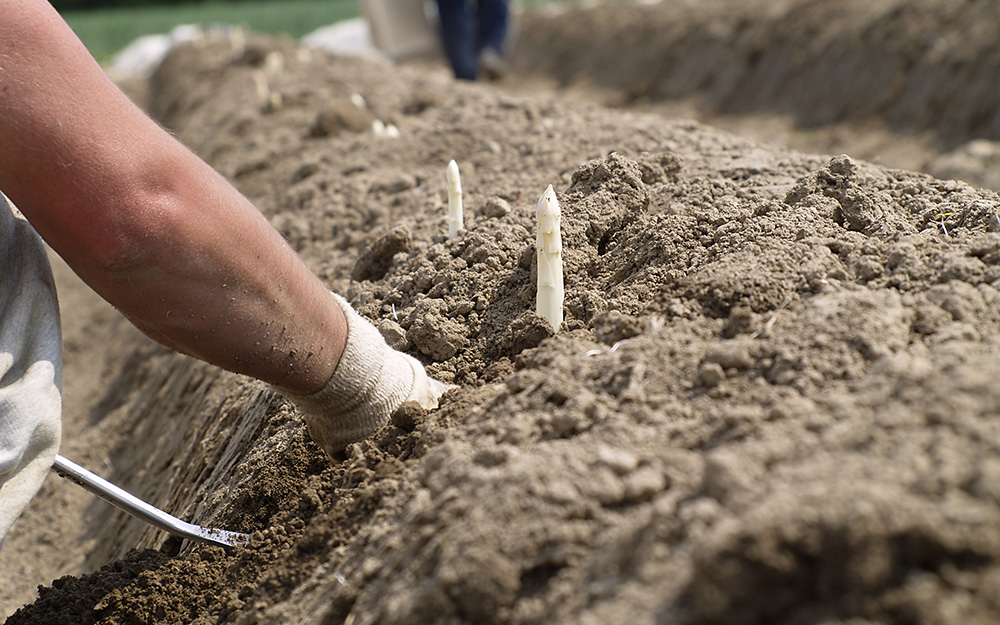
- After all danger of frost in your area has passed, dig a trench 6 to 8 inches wide. Gardeners used to dig trenches 18 inches deep, but today’s new and improved varieties can be planted 6 to 12 inches deep. Mound the soil on the sides, so you can add it back in later.
- Make the trench as long as you want, but if you’re digging more than one, keep them 4 to 5 feet apart.
- Put the asparagus crowns in the trenches, spacing them 12 to 18 inches apart and spreading out the roots. Partially refill each trench with the soil from the sides, covering the crowns 2 to 3 inches deep, and water them in.
- When you plant, also apply an organic vegetable fertilizeror a 10-10-10 fertilizer in the amount recommended on your product label. Reapply during the growing season as directed. Always water thoroughly after fertilizing.
- Gradually rake more soil back into the trenches as the plants grow, or until the bed is level with the ground around it. Avoid covering the spears as they emerge.
- Add 4 to 6 inches of loose mulch to help prevent weeds.
- Keep the bed moist during the growing season. Ideally, the water should soak into the soil about 8 inches deep. If there’s not enough rainfall, use the soaker hose or drip irrigation system you added in the fall, or add one now. Water from a garden hose will run off too fast to really penetrate the ground.
How to Harvest Asparagus
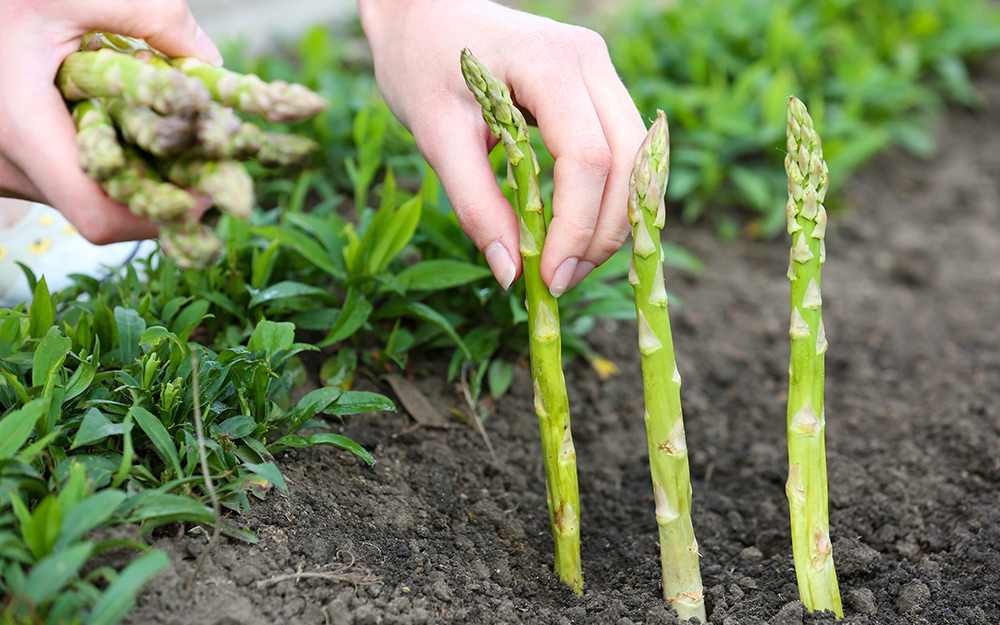
- It’s tempting to want to cut the first asparagus shoots you see and rush them to the kitchen. But if you can be patient and let the plants mature for two or three years, you’ll get a bigger harvest in the long run.
- If you can’t wait, limit yourself in the first year to cutting spears over a 10-day period. In the second year, harvest for up to two weeks. In the third year, harvest for up to six weeks.
- Snap off the spears at ground level when they’re about 5 to 7 inches tall or before they start opening and producing foliage. Once they open, they’ll be tough.
- Leave any spears that are thinner than the diameter of a pencil. Once they’re established, your plants may produce a crop for up to 8 weeks each year.
- After harvesting, let the plants continue to grow. They’ll produce ferns, or lacey, light green foliage that grows about 4 to 6 feet tall. Wait until a frost makes the ferns turn brown and then cut them down to about an inch above the ground.
- Add the ferns to your compost pile, as long as they don’t show any signs of pests or diseases. If they do, discard them.
- Keep the asparagus bed tidy to help prevent insects from overwintering. You can also take this time to clear out any weeds or grasses that have sprouted.
How to Preserve Asparagus
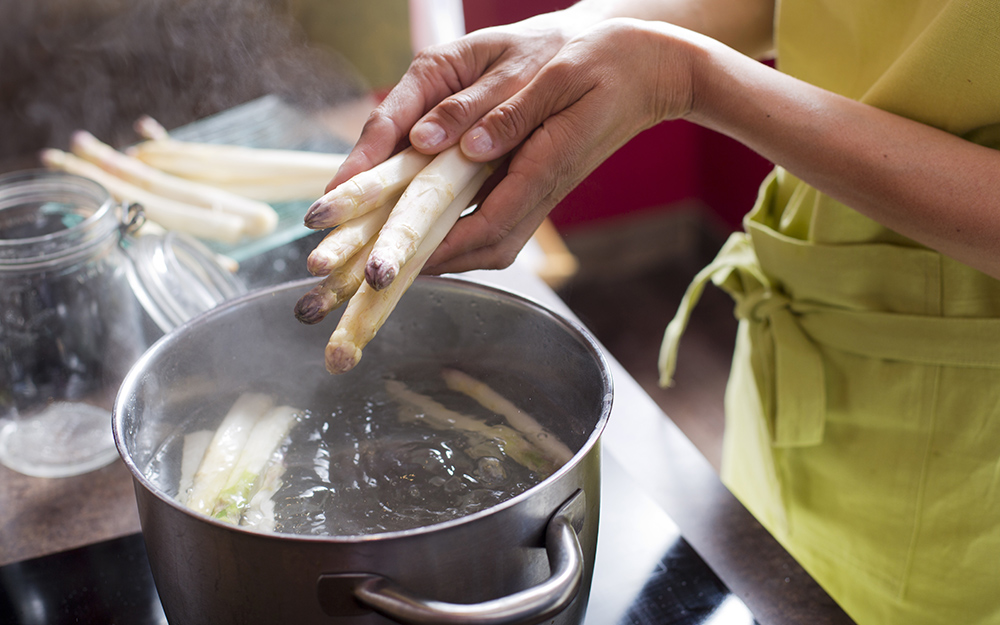
After harvesting your shoots, trim any tough tissue from the bases. Then cook them right away in a stock pot with a basket insert, or wrap them in plasticwrap and store them in your refrigerator, where they’ll last for about a week.
You can also can asparagus.
To freeze the spears, put them in a pot of boiling water to blanch them for 3 to 5 minutes. (Blanching is a process that stops enzymes from causing some foods to lose their color, flavor and texture.)
Remove the pot from the heat, drain the spears and run cold water over them. Let them drain again and wrap them to store in the freezer.
How to Handle Insects and Diseases
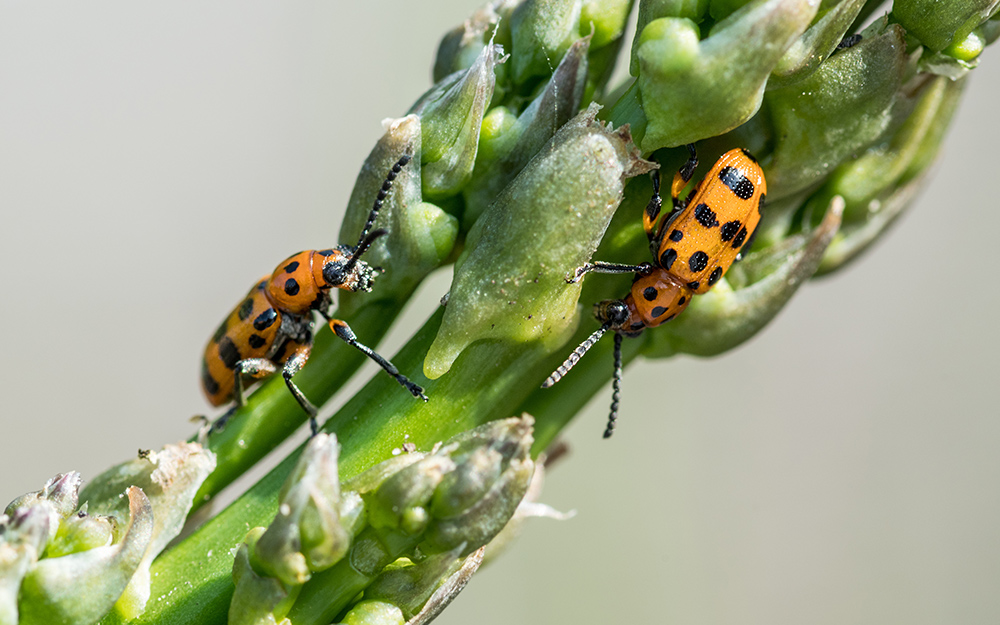
Sometimes asparagus is affected by diseases like fusarium wilt, crown rot and rust. Small, wilted spears signal fusarium wilt. Crown rot shows up as rotting tissues between stems and roots. Rust looks like small, orange patches on foliage and shoots.
- The best way to prevent these problems is to plant disease-resistant varieties in the first place.
- It also helps to make sure your planting bed drains easily, since diseases can spread in warm, wet conditions.
Asparagus beetles, aphids and thrips are insects that can cause trouble.
- Again, for good results, plant varieties recommended for your region. If there aren't a lot of insect pests on your plants, wear gardening gloves to pick them off
and drop them into a pail of soapy water. - To handle large numbers of pests, use beneficial nematodes. They destroy the larva and pupal stages of certain insects when they’re in the ground and later, when they turn into adults and come out of the ground.
- Don't get rid of "good bugs" like ladybugs and lacewings in your garden. They'll eat the eggs and larvae of some “bad bugs” and help control them.
- You can also use organic insecticides that will protect your plants but won't kill the bees that are so important to our ecosystem.
How to Grow Male and Female Asparagus Plants
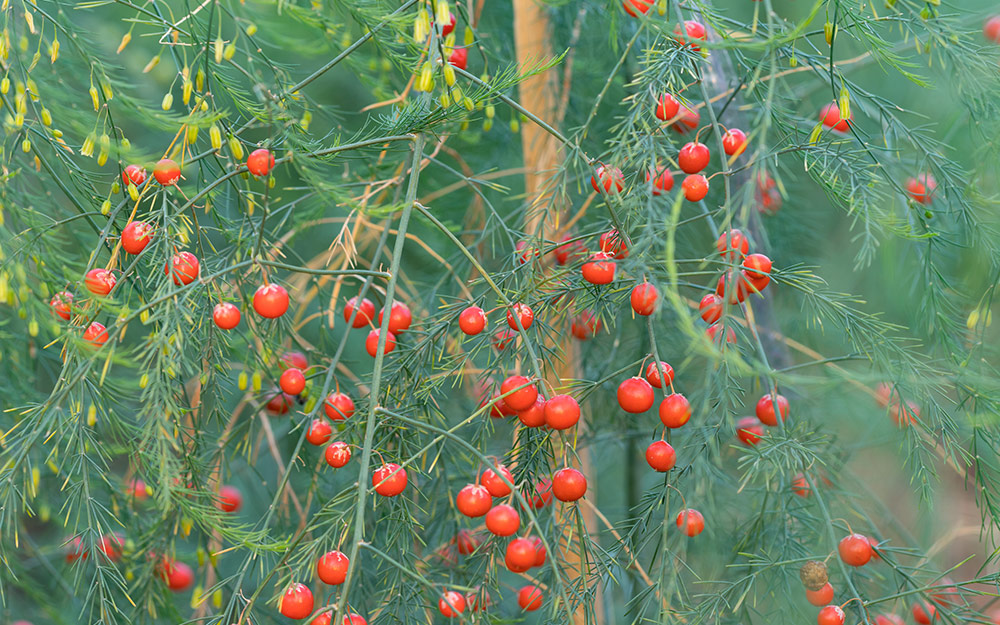
You may have heard of male and female asparagus plants. They really do exist! Males have larger flowers than females and produce larger shoots. Females produce seeds that look like little red berries and have fewer, smaller shoots. Some gardeners remove their female plants and replace them with males to get a bigger yield.
Some male asparagus hybrids include 'Jersey Giant,' 'Jersey King' and 'Jersey Knight.' They are cold tolerant, resistant to common asparagus diseases, and produce a big harvest of large spears.
Types of Asparagus
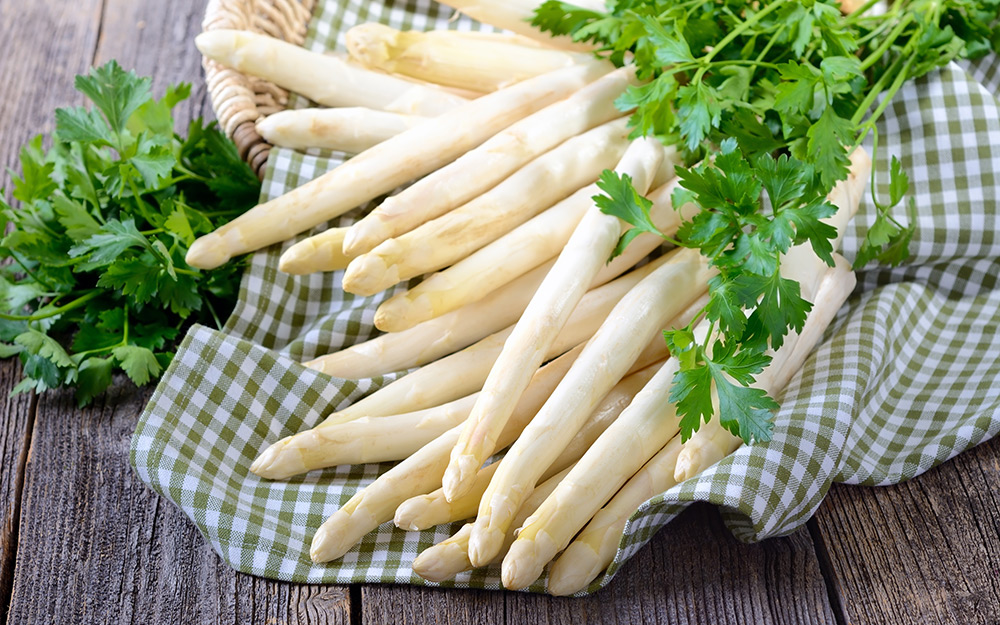
Asparagus can be white, purple or green. Purple varieties are purple on the outside and green on the inside, but their purple hue fades when the spears are cooked. Some cooks and gardeners say they taste slightly sweet, probably because their stalks contain more sugar than the green varieties. They’re grown like green asparagus.
White asparagus is just green asparagus that has developed underground. To grow it, mound a thick layer of dirt over your plants or cover them with black plastic to block the sun. Without sunlight, the plants can’t make the chlorophyll that gives them their green color. White asparagus usually has a milder flavor than green types, but they can be a little bitter.
White asparagus stalks can be fibrous, too, so peel the bottom two-thirds of the stalks before cooking them, and cook them thoroughly. Thick, white stalks are better for grilling, roasting or simmering. Try serving them with melted butter or hollandaise sauce.
Whether you need the right plants, tools or garden soil, The Home Depot delivers
online orders
when and where you need them.
